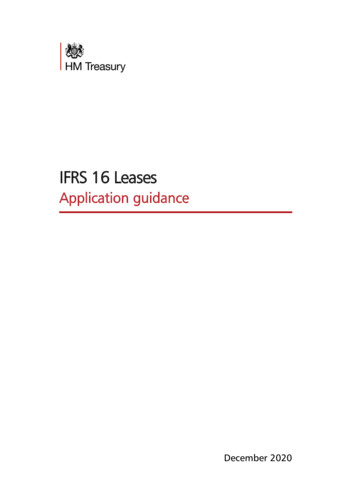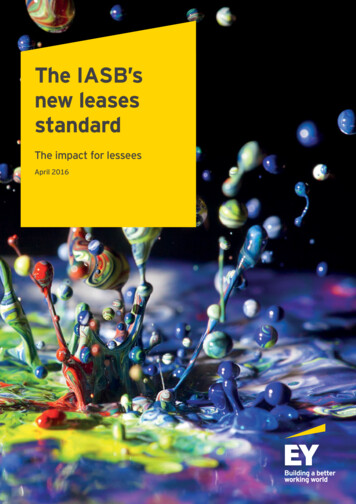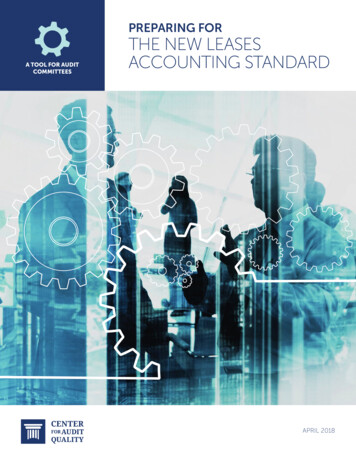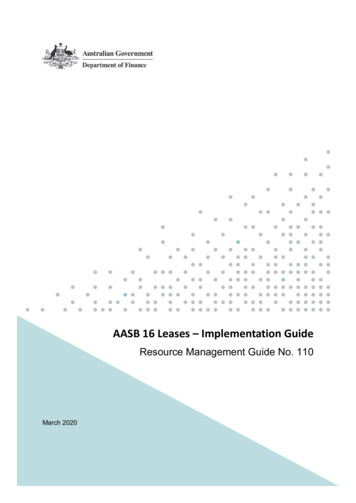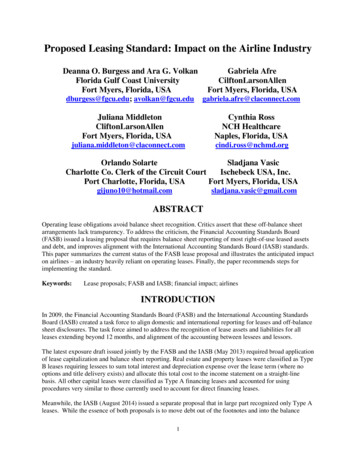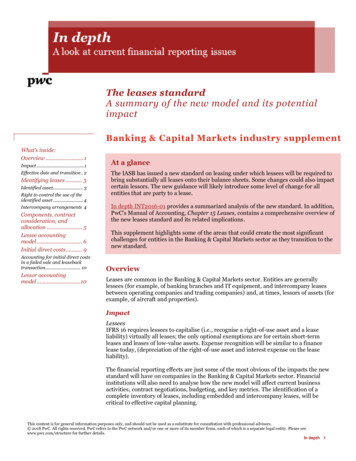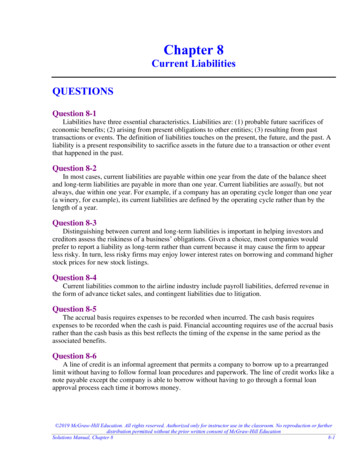
Transcription
Chapter 8Current LiabilitiesQUESTIONSQuestion 8-1Liabilities have three essential characteristics. Liabilities are: (1) probable future sacrifices ofeconomic benefits; (2) arising from present obligations to other entities; (3) resulting from pasttransactions or events. The definition of liabilities touches on the present, the future, and the past. Aliability is a present responsibility to sacrifice assets in the future due to a transaction or other eventthat happened in the past.Question 8-2In most cases, current liabilities are payable within one year from the date of the balance sheetand long-term liabilities are payable in more than one year. Current liabilities are usually, but notalways, due within one year. For example, if a company has an operating cycle longer than one year(a winery, for example), its current liabilities are defined by the operating cycle rather than by thelength of a year.Question 8-3Distinguishing between current and long-term liabilities is important in helping investors andcreditors assess the riskiness of a business’ obligations. Given a choice, most companies wouldprefer to report a liability as long-term rather than current because it may cause the firm to appearless risky. In turn, less risky firms may enjoy lower interest rates on borrowing and command higherstock prices for new stock listings.Question 8-4Current liabilities common to the airline industry include payroll liabilities, deferred revenue inthe form of advance ticket sales, and contingent liabilities due to litigation.Question 8-5The accrual basis requires expenses to be recorded when incurred. The cash basis requiresexpenses to be recorded when the cash is paid. Financial accounting requires use of the accrual basisrather than the cash basis as this best reflects the timing of the expense in the same period as theassociated benefits.Question 8-6A line of credit is an informal agreement that permits a company to borrow up to a prearrangedlimit without having to follow formal loan procedures and paperwork. The line of credit works like anote payable except the company is able to borrow without having to go through a formal loanapproval process each time it borrows money. 2019 McGraw-Hill Education. All rights reserved. Authorized only for instructor use in the classroom. No reproduction or furtherdistribution permitted without the prior written consent of McGraw-Hill EducationSolutions Manual, Chapter 88-1
answers to Questions (continued)Question 8-7If a company borrows from another company rather than from a bank, the note is referred to ascommercial paper. The interest rate is often lower for commercial paper than a bank loan as thecompany is effectively bypassing the additional mark-up in interest rates by the bank.Question 8-8Four items commonly withheld from employee payroll checks include (1) federal and stateincome taxes, (2) Social Security and Medicare (FICA), (3) health, dental, disability, and lifeinsurance premiums, and (4) employee investments to retirement or savings plans. The first two arerequired by law and the second two are voluntary.Question 8-9Four common employer costs in addition to the employee’s salary include (1) federal and stateunemployment taxes, (2) the employer portion of Social Security and Medicare (FICA), (3)employer contributions for health, dental, disability, and life insurance, and (4) employercontributions to retirement or savings plans. The first two are required by law and the last two arevoluntary benefits paid by a company on behalf of its employees.Question 8-10Both the employer and the employee pay equal portions of social security taxes. Employerswithhold from employee paychecks a 6.2% Social Security tax up to a maximum base amount and a1.45% Medicare tax with no maximum. Therefore, the total FICA tax is 7.65% (6.2% 1.45%) onincome up to a base amount for Social Security ( 128,400 in 2018) and 1.45% on all income abovethe base amount. Employers then pay an additional (matching) amount equal to the amount withheldfrom employee paychecks so the government actually is collecting 15.3% (7.65% employee 7.65%employer) on each employee’s salary.Question 8-11When a company receives cash in advance through the sale of gift cards, it debits cash andcredits a current liability account called deferred revenue. When it provides the goods or servicesalready paid for, the company debits deferred revenue and credits revenue.Question 8-12(a) When Sports Illustrated sells magazine subscriptions, the company will debit cash and creditdeferred revenue. (b) As the subscription is provided through the distribution of magazines, thecompany debits deferred revenue and credits revenue. 2019 McGraw-Hill Education. All rights reserved. Authorized only for instructor use in the classroom. No reproduction or furtherdistribution permitted without the prior written consent of McGraw-Hill Education8-2Financial Accounting, 5e
answers to Questions (continued)Question 8-13The sales tax rate for Hollister is 6.5% calculated as 325 in sales taxes divided by sales of 5,000. The journal entry to record the transaction would debit cash for 5,325, credit sales for 5,000, and credit sales taxes payable for 325.Question 8-14Dell will include 10 million as a current note payable and the remaining 120 million as part oflong-term notes payable.Question 8-15A contingent liability is an existing, uncertain situation that might result in a loss. Examplesinclude lawsuits, product warranties, environmental problems, and premium offers.Question 8-16The likelihood of the loss occurring can be probable, reasonably possible, or remote. Probablemeans likely to occur while remote means the chance is slight. Reasonably possible fits somewherein between—more than remote but less than probable.Question 8-17A loss contingency is recorded only if a loss is probable and the amount is reasonably estimable.Question 8-18If the likelihood of loss is reasonably possible rather than probable, we record no entry but makefull disclosure in a disclosure note to the financial statements to describe the contingency. Finally, ifthe likelihood of loss is remote, disclosure is usually not required.Question 8-19If one amount within a range of potential losses appears more likely than other amounts withinthe range, we record that amount. When no amount within the range appears more likely than others,we record the minimum amount and disclose information about the potential loss including thepotential range of loss. 2019 McGraw-Hill Education. All rights reserved. Authorized only for instructor use in the classroom. No reproduction or furtherdistribution permitted without the prior written consent of McGraw-Hill EducationSolutions Manual, Chapter 88-3
answers to Questions (continued)Question 8-20In a pending lawsuit, one side—the defendant—faces a loss contingency, while the other side—the plaintiff—has a gain contingency. The 2 million is a gain contingency and the outcome, whilepromising, is not yet certain. We do not record gain contingencies of this type until the gain iscertain. Though firms do not record gain contingencies in the accounts, they sometimes disclosethem in notes to the financial statements.Question 8-21Liquidity measures the ability of a company to pay current liabilities as they come due. Liquiditycan be evaluated by examining the current ratio or the more specific acid-test ratio.Question 8-22Working capital is simply the difference between current assets and current liabilities. Thecurrent ratio is calculated by dividing current assets by current liabilities. The acid-test ratio issimilar to the current ratio but is based on a more conservative measure of current assets available topay current liabilities. We calculate the acid-test ratio by dividing “quick assets” by currentliabilities. Quick assets include only cash, short-term investments, and accounts receivable. Byeliminating current assets such as inventories and prepaid expenses that are less readily convertibleinto cash, the acid-test ratio may provide a better indication of a company’s liquidity than does thecurrent ratio.Question 8-23(a) The purchase of inventory with cash would have no effect on the current ratio as one currentasset (inventory) would increase while another current asset (cash) would decrease. The purchase ofinventory with cash would decrease the acid-test ratio due to the decrease in cash. (b) The sale ofinventory for more than its cost would increase the current ratio because the increase in cash oraccounts receivable from the sale would more than offset the reduction of inventory at its cost. Thesale of inventory for more than its cost would also increase the acid-test ratio due to the increase incash or accounts receivable from the sale. 2019 McGraw-Hill Education. All rights reserved. Authorized only for instructor use in the classroom. No reproduction or furtherdistribution permitted without the prior written consent of McGraw-Hill Education8-4Financial Accounting, 5e
BRIEF EXERCISESBrief Exercise 8-1November 1CashNotes PayableDebit4,000,000December 31Interest Expense (4,000,000 0.06 2/12)Interest PayableBrief Exercise 8-2November 1Notes 0,000Credit4,000,000December 31Interest Receivable40,000Interest Revenue (4,000,000 0.06 2/12)40,000Brief Exercise 8-3InterestExpense 4,800 Facevalue 160,000 Annualinterest rate6% Fractionof the year6/12 2019 McGraw-Hill Education. All rights reserved. Authorized only for instructor use in the classroom. No reproduction or furtherdistribution permitted without the prior written consent of McGraw-Hill EducationSolutions Manual, Chapter 88-5
Brief Exercise 8-4April 1CashNotes Payable - Commercial PaperDebit13,000,000Credit13,000,000December 31Notes Payable - Commercial PaperInterest Expense ( 13,000,000 0.09 9/12)Cash13,000,000877,50013,877,500Brief Exercise 8-5Total withheld for:Social Security 128,400 0.062Medicare 652,800 0.0145Total 7,9619,466 17,427The employer will contribute an additional (matching) 17,427.Brief Exercise 8-6December 18CashDeferred Revenue(to record advance receipt of cash)January 23CashDeferred RevenueSales RevenueCost of Goods SoldInventory(to complete the 0,0002,600,0001,600,000Brief Exercise 8-7 2019 McGraw-Hill Education. All rights reserved. Authorized only for instructor use in the classroom. No reproduction or furtherdistribution permitted without the prior written consent of McGraw-Hill Education8-6Financial Accounting, 5e
JuneJulyAugust 1,2002,1001,700** Includes gift cards redeemed ( 1,400) and gift cards unlikely to be redeemed ( 300).Brief Exercise 8-8Accounts ReceivableSales RevenueSales Taxes Payable (0.085 3,200)Debit3,472Credit3,200272Brief Exercise 8-9Southwest AirlinesPartial Balance SheetDecember 31, 2021Current Liabilities:Current portion of long-term debtLong-Term Liabilities:Notes payableTotal LiabilitiesBrief Exercise 8-10Warranty Expense ( 31,000,000 x 3%)Warranty LiabilityWarranty LiabilityCash 10,000,00031,000,000 he Warranty Liability at the end of the year is 630,000, calculated using a Taccount as follows:Warranty Liability300,000 930,000630,000 balance 2019 McGraw-Hill Education. All rights reserved. Authorized only for instructor use in the classroom. No reproduction or furtherdistribution permitted without the prior written consent of McGraw-Hill EducationSolutions Manual, Chapter 88-7
Brief Exercise 8-11The loss contingency is probable and reasonably estimable, so a loss and a liability for 8 million must be recorded. The entry will reduce income before taxes on the incomestatement and increase total liabilities on the balance sheet by 8 million.Brief Exercise 8-12Electronic Innovators has a contingent liability that is probable, and reasonablyestimable within a range between 6 and 10 million. Electronic Innovators shouldrecord a loss and a liability for the minimum amount ( 6 million) and disclose therange between 6 and 10 million in the notes to the financial statements.Brief Exercise 8-13Aviation Systems has a contingent gain that is probable and reasonably estimable,within a range between 6 and 10 million. Contingent gains are not recorded untilthe gain is certain. Though firms do not record contingent gains in the accounts, theysometimes disclose them in the notes to the financial statements.Brief Exercise 8-14Northwest Forest Products has a contingent liability that is reasonably possible andreasonably estimable, within a range between 20 and 30 million. Since the loss isreasonably possible, but not probable, we will carefully disclose the situation, but notrecord the potential loss and liability in the financial records. Details regarding theinvestigation by the EPA, the reasonable possibility of an assessment, and the range ofsettlements should be included in the disclosure. 2019 McGraw-Hill Education. All rights reserved. Authorized only for instructor use in the classroom. No reproduction or furtherdistribution permitted without the prior written consent of McGraw-Hill Education8-8Financial Accounting, 5e
Brief Exercise 8-15(1) Not recorded (disclosure only) as the loss is reasonably possible, but not probable.(2) Not recorded (disclosure only) as the loss is not reasonably estimable.(3) Recorded because the warranty costs are probable and reasonably estimable.Brief Exercise 8-16Current Assets ( 112 104 192 28) Current Liabilities( 118 45) Current Ratio2.67 Current Liabilities( 118 45) Acid-Test Ratio1.33Quick Assets( 112 104)Brief Exercise 8-171. Provide services to customers on account.2. Borrow cash from the bank by signing along-term note payable.3. Purchase office supplies with cash4. Pay rent for the current ncreaseIncreaseNo changeDecreaseDecreaseDecrease 2019 McGraw-Hill Education. All rights reserved. Authorized only for instructor use in the classroom. No reproduction or furtherdistribution permitted without the prior written consent of McGraw-Hill EducationSolutions Manual, Chapter 88-9
EXERCISESExercise 8-1Reporting MethodC. Current liabilityL. Long-term liabilityD. Disclosure note onlyN. Not reportedItemCCCCLCCDCD1. Accounts payable.2. Current portion of long-term debt.3. Sales tax collected from customers.4. Notes payable due next year.5. Notes payable due in two years.6. Advance payments from customer.7. Commercial paper.8. Unused line of credit.9. A contingent liability with a probable likelihood ofoccurring within the next year and can be estimated.10. A loss contingency with a reasonably possiblelikelihood of occurring within the next year and can beestimated. 2019 McGraw-Hill Education. All rights reserved. Authorized only for instructor use in the classroom. No reproduction or furtherdistribution permitted without the prior written consent of McGraw-Hill Education8-10Financial Accounting, 5e
Exercise 8-21. November 1, 2021CashNotes Payable(Issuance of notes payable)Debit60,0002. December 31, 2021Interest Expense ( 60,000 7% 2/12)700Interest Payable(Interest expense incurred, but not paid)3. January 31, 2022Notes Payable60,000Interest Payable ( 60,000 7% 2/12)700Interest Expense ( 60,000 7% 1/12)350Cash(Payment of notes payable and interest)Credit60,00070061,050 2019 McGraw-Hill Education. All rights reserved. Authorized only for instructor use in the classroom. No reproduction or furtherdistribution permitted without the prior written consent of McGraw-Hill EducationSolutions Manual, Chapter 88-11
Exercise 8-31. August 1, 2021CashNotes Payable(Issuance of notes payable)Debit21,000,0002. December 31, 2021Interest Expense ( 21 million 9% 5/12)787,500Interest Payable(Interest expense incurred, but not paid)3. January 31, 2022Notes Payable21,000,000Interest Payable ( 21 million 9% 5/12)787,500Interest Expense ( 21 million 9% 1/12)157,500Cash(Payment of notes payable and interest)Credit21,000,000787,50021,945,000 2019 McGraw-Hill Education. All rights reserved. Authorized only for instructor use in the classroom. No reproduction or furtherdistribution permitted without the prior written consent of McGraw-Hill Education8-12Financial Accounting, 5e
Exercise 8-41. August 1, 2021Notes ReceivableCash(Issuance of notes receivable)Debit21,000,0002. December 31, 2021Interest Receivable ( 21 9% 5/12)787,500Interest Revenue(Interest revenue earned, but not received)3. January 31, 2022Cash21,945,000Notes ReceivableInterest Receivable ( 21 9% 5/12)Interest Revenue ( 21 9% 1/12)(Collection of notes receivable and 57,500Exercise 8-51.2.3.4. 6,000,000 6,000,000 6,000,000 6,000,000 0.110.090.100.07 6/12 3/12 4/12 7/12 330,000 135,000 200,000 245,000 2019 McGraw-Hill Education. All rights reserved. Authorized only for instructor use in the classroom. No reproduction or furtherdistribution permitted without the prior written consent of McGraw-Hill EducationSolutions Manual, Chapter 88-13
Exercise 8-6January 13No EntryFebruary 1CashNotes PayableMay 1Notes PayableInterest Expense ( 5,000,000 0.07 0 2019 McGraw-Hill Education. All rights reserved. Authorized only for instructor use in the classroom. No reproduction or furtherdistribution permitted without the prior written consent of McGraw-Hill Education8-14Financial Accounting, 5e
Exercise 8-7Requirement 1Total Salary ExpenseLess: WithholdingsFederal Income TaxesState Income TaxesFICA TaxesTotal WithholdingsActual Direct DepositRequirement 2FICA TaxesUnemployment TaxesTotal Payroll Tax Expense(100 40 hours 20)( 80,000 0.15)( 80,000 0.05)( 80,000 0.0765) 80,000 12,0004,0006,12022,120 57,880( 80,000 0.0765)( 80,000 0.062) 6,1204,960 11,080Requirement 3The company does not make an accounting entry to record the free skiing given toemployees on their days off; no additional costs are directly incurred by the companyto provide this benefit. 2019 McGraw-Hill Education. All rights reserved. Authorized only for instructor use in the classroom. No reproduction or furtherdistribution permitted without the prior written consent of McGraw-Hill EducationSolutions Manual, Chapter 88-15
Exercise 8-8Requirement 1January 313,000,000Salaries ExpenseIncome Tax Payable637,500FICA Tax Payable229,500Accounts Payable (to Blue Cross/Blue Shield)30,000Salaries Payable (to balance)2,103,000(Employee salary expense and withholdings)Requirement 2January 3190,000Salaries Expense (fringe benefits)Accounts Payable (to Blue Cross/Blue Shield)(Employer-provided fringe benefits)Requirement 3January 31Payroll Tax ExpenseFICA Tax PayableUnemployment Tax Payable(Employer payroll taxes)90,000415,500229,500186,000 2019 McGraw-Hill Education. All rights reserved. Authorized only for instructor use in the classroom. No reproduction or furtherdistribution permitted without the prior written consent of McGraw-Hill Education8-16Financial Accounting, 5e
Exercise 8-9January 31600,000Salaries ExpenseIncome Tax PayableFICA Tax Payable ( 600,000 0.0765)Salaries Payable (to balance)(Employee salary expense)January 3183,100Payroll Tax Expense (total)FICA Tax Payable ( 600,000 0.0765)Unemployment Tax Payable ( 600,000 0.062)(Employer payroll tax expense)120,00045,900434,10045,90037,200 2019 McGraw-Hill Education. All rights reserved. Authorized only for instructor use in the classroom. No reproduction or furtherdistribution permitted without the prior written consent of McGraw-Hill EducationSolutions Manual, Chapter 88-17
Exercise 8-10Requirement 1November 30Cash21,000,000Deferred Revenue(Advance collection for gift cards)21,000,000Requirement 2December 31Deferred Revenue14,000,000Sales Revenue14,000,000(Revenue recognized when gift cards are redeemed)Requirement 3The ending balance in Deferred Revenue is 7,000,000.Deferred Revenue14,000,000 21,000,0007,000,000 Ending balanceExercise 8-11Requirement 1October 1, 2021CashDeferred Revenue(Sale of gift cards)100,000100,000Requirement 2December 31, 2021Deferred Revenue20,000Sales Revenue20,000(Revenue recognized when gift cards are redeemed) 2019 McGraw-Hill Education. All rights reserved. Authorized only for instructor use in the classroom. No reproduction or furtherdistribution permitted without the prior written consent of McGraw-Hill Education8-18Financial Accounting, 5e
Requirement 3March 31, 2022Deferred Revenue70,000Sales Revenue70,000(Revenue recognized when gift cards are redeemed)( 70,000 30,000 25,000 15,000)Requirement 4April 1, 2022Deferred Revenue10,000Sales Revenue(Revenue expiration of gift cards)( 10,000 100,000 20,000 70,000)10,000 2019 McGraw-Hill Education. All rights reserved. Authorized only for instructor use in the classroom. No reproduction or furtherdistribution permitted without the prior written consent of McGraw-Hill EducationSolutions Manual, Chapter 88-19
Exercise 8-12Requirement 1The contingent liability is probable and reasonably estimable, so it must be reported.Requirement 2A 4 million loss should be reported in its 2021 income statement.Requirement 3A 4 million liability should be reported in its 2021 balance sheet.Requirement 4LossContingent Liability(Record the contingent liability)4,000,0004,000,000 2019 McGraw-Hill Education. All rights reserved. Authorized only for instructor use in the classroom. No reproduction or furtherdistribution permitted without the prior written consent of McGraw-Hill Education8-20Financial Accounting, 5e
Exercise 8-13Requirement 1The contingent liability is probable and reasonably estimable, so it must be recordedas follows:LossContingent Liability(Record the contingent liability)1,300,0001,300,000Requirement 2Pacific Cruise Lines should record a loss and a liability for the minimum amount ( 1.1million) and disclose the nature of the contingency in the disclosure notes to thefinancial statements. The journal entry is as follows:LossContingent Liability(Record the contingent liability)1,100,0001,100,000Requirement 3If the likelihood of loss is reasonably possible rather than probable, we record no entrybut make full disclosure in a note to the financial statements to describe thecontingency.Requirement 4If the likelihood of loss is remote, disclosure is usually not required. 2019 McGraw-Hill Education. All rights reserved. Authorized only for instructor use in the classroom. No reproduction or furtherdistribution permitted without the prior written consent of McGraw-Hill EducationSolutions Manual, Chapter 88-21
Exercise 8-14Requirement 1Yes, it’s probable that costs for warranties will be incurred and based on previousexperience the amount is reasonably estimable.Requirement 2December 31Warranty Expense ( 600,000 6%)Warranty Liability(Record contingent liability for warranties)36,000Requirement 3January 31Warranty LiabilityCash(Record actual warranty expenditures)13,00036,00013,000Requirement 4Warranty Liability36,000 ExpensePayment 13,00023,000 Balance 2019 McGraw-Hill Education. All rights reserved. Authorized only for instructor use in the classroom. No reproduction or furtherdistribution permitted without the prior written consent of McGraw-Hill Education8-22Financial Accounting, 5e
Exercise 8-15Requirement 1December 31, 2021Warranty Expense ( 1,600,000 2%)Warranty Liability(Record contingent liability for warranties)32,000Requirement 2Summary entry in 2022Warranty LiabilityCash(Record actual warranty expenditures)25,000Requirement 3December 31, 2022Warranty Expense29,000Warranty Liability(Record contingent liability for warranties)( 36,000 2,400,000 1.5%)( 29,000 36,000 7,000 current balance in Warranty Liability)32,00025,00029,000Requirement 4Warranty Liability032,000 Adjusting entry32,000 Balance in 2021Payment in 2022 25,0007,00029,000 Adjusting entry36,000 Balance in 2022 2019 McGraw-Hill Education. All rights reserved. Authorized only for instructor use in the classroom. No reproduction or furtherdistribution permitted without the prior written consent of McGraw-Hill EducationSolutions Manual, Chapter 88-23
Exercise 8-16Requirement 1Yes, a contingent liability is an existing, uncertain situation that might result in a loss.The environmental remediation and restoration costs represent an existing uncertainsituation that will likely result in a loss to the company.Requirement 2Dow would record a contingency if the loss is probable and is reasonably estimable.Requirement 3LossContingent Liability(Record the contingent liability)381,000,000381,000,000 2019 McGraw-Hill Education. All rights reserved. Authorized only for instructor use in the classroom. No reproduction or furtherdistribution permitted without the prior written consent of McGraw-Hill Education8-24Financial Accounting, 5e
Exercise 8-17Requirement 1Current Assets 875 Current Liabilities 2,638 Current Ratio0.33Quick Assets 331 63 230 Current Liabilities 2,638 Acid-Test Ratio0.24Requirement 2Queen’s Line has a lower current ratio and a lower acid-test ratio than either UnitedAirlines or American Airlines reported in the text. Queen’s Line appears more likelyto have difficulty paying its currently maturing debts. 2019 McGraw-Hill Education. All rights reserved. Authorized only for instructor use in the classroom. No reproduction or furtherdistribution permitted without the prior written consent of McGraw-Hill EducationSolutions Manual, Chapter 88-25
Exercise 8-18Requirement 1 Transactions during January, 2021January 2CashDeferred Revenue(Sell gift cards for cash)Debit8,000CreditJanuary 6InventoryAccounts Payable(Purchase inventory on account)Debit147,000CreditJanuary 15Accounts ReceivableSales Revenue(Sell inventory on account)Cost of Goods SoldInventory(Record cost of inventory sold)January 23CashAccounts Receivable(Receive cash on account)Debit135,000January 25Accounts PayableCash(Pay cash on account)January 28Allowance for Uncollectible AccountsAccounts Receivable(Write off uncollectible accounts)January 30CashAccounts ReceivableSales Revenue(Sell inventory for cash and on account)Cost of Goods SoldInventory(Record cost of inventory sold)January 31Salaries ExpenseCash(Pay monthly Credit143,00079,500Credit52,000 2019 McGraw-Hill Education. All rights reserved. Authorized only for instructor use in the classroom. No reproduction or furtherdistribution permitted without the prior written consent of McGraw-Hill Education8-26Financial Accounting, 5e
Exercise 8-18 (continued)Requirement 2 Adjusting entries at end of January, 2021(a) January 31Depreciation ExpenseAccumulated Depreciation(Record depreciation for January)( 500 [ 15,000 3,000] / 24 months)Debit500Credit500(b) January 31DebitCreditBad Debt Expense12,500Allowance for Uncollectible Accounts12,500(Adjust uncollectible accounts)( 12,500 [ 11,000 30%] [ 172,000a 5%] 600b)a 172,000 46,200 135,000 125,400 4,800 132,000 11,000b 600 4,800 4,200(c) January 31Interest ExpenseInterest Payable(Adjust interest expense)( 250 50,000 6% 1/12)(d) January 31Income Tax ExpenseIncome Tax Payable(Adjust income taxes)(e) January 31Deferred RevenueSales Revenue(Adjust revenue for gift cards ebit3,000Credit3,000 2019 McGraw-Hill Education. All rights reserved. Authorized only for instructor use in the classroom. No reproduction or furtherdistribution permitted without the prior written consent of McGraw-Hill EducationSolutions Manual, Chapter 88-27
Exercise 8-18 (continued)Requirement 3ACME FireworksAdjusted Trial BalanceJanuary 31, 2021AccountsCashAccounts ReceivableInventoryLandEquipmentAllowance for Uncollectible AccountsAccumulated DepreciationAccounts PayableDeferred Revenue (gift cards liability)Interest PayableIncome Tax PayableNotes PayableCommon StockRetained EarningsSales RevenueCost of Goods SoldSalaries ExpenseBad Debt ExpenseDepreciation ExpenseInterest ExpenseIncome Tax ExpenseTotalsDebit 50025013,000 516,750Credit 81,000 516,750 2019 McGraw-Hill Education. All rights reserved. Authorized only for instructor use in the classroom. No reproduction or furtherdistribution permitted without the prior written consent of McGraw-Hill Education8-28Financial Accounting, 5e
Exercise 8-18 (continued)Requirement 3 (concluded)AccountsEndingBalanceCash 27,500Accounts t15,000Allow for Unc. Accounts11,900Accumulated Depreciation2,000Accounts Payable85,500Deferred Revenue5,000Interest Payable250Income Tax Payable13,000Notes Payable50,000Common Stock35,000Retained Earnings33,100Sales Revenue281,000Cost of Goods Sold153,300Salaries Expense52,000Bad Debt Expense12,500Depreciation Expense500Interest Expense250Income Tax Expense13,000 Beginning balance in bold, entries during January in blue,and adjusting entries in red.25,100 8,000 125,400 90,000 11,000 52,00046,200 135,000 125,400 4,800 132,00020,000 147,000 73,800 79,50046,00015,0004,200 4,800 12,5001,500 50028,500 147,000 90,0008,000 3,00025013,00050,00035,00033,100135,000 143,000 3,00073,800 79,50052,00012,50050025013,000 2019 McGraw-Hill Education. All rights reserved. Authorized only for instructor use in the classroom. No reproduction or furtherdistribution permitted without the prior written consent of McGraw-Hill EducationSolutions Manual, Chapter 88-29
Exercise 8-18 (continued)Requirement 4ACME FireworksMultiple-Step Income StatementFor the year ended January 31, 2021Sales revenue 281,00
Current liabilities common to the airline industry include payroll liabilities, deferred revenue in the form of advance ticket sales, and contingent liabilities due to litigation. Question 8-5 The accrual basis requires expenses to be recorded when incurred. The cash basis requires expenses to be recorded when the cash is paid.


